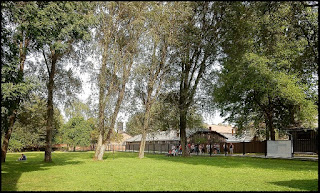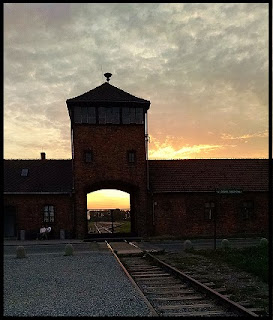While World War II and its aftermath were
horrible and there were more
tragic occurrences than have ever been reported,
the worst was the Holocaust. This came about because of bigotry and hatred, two
characteristics of mankind that the winning of any war or the embracing of any
religion has not obliterated from our collective consciences. One of the most interesting
stories was told by Jakob, our Free Walking Tour guide, was about his
grandmother. For many of the people in Poland the war didn’t end in 1945; his
grandmother still overbuys when she goes to the grocery just in case they need
the food to flee. When US leaders start talking about ‘registering’ people, the
first thing that springs to mind is how the Jews and other minorities were
‘registered’. Let’s hope the population in this country never has to make the
choices that the people in Europe had to make.
I was under the mistaken impression that Auschwitz was a single camp somewhere in Germany. It was actually a series of Nazi concentration
camps and extermination camps that were built and operated by the
Third Reich in areas of Poland that had been annexed by Nazi Germany during
World War II. Auschwitz I was the original camp; Auschwitz II–Birkenau was a
combination concentration and extermination camp; Auschwitz III–Monowitz was a
labor camp used to staff an IG
Farben factory, chemical manufacturers; and there were another 45 satellite
camps.
The first people to arrive at Auschwitz I came in May 1940. These were the Polish political prisoners, many of whom were scientists, university
professors, and other well educated people. In many
cases people were lured into settings where they could be arrested en masse.
For instance, at Krakow University there was supposed to be a gathering of
scientists to talk about their research. One in their group arrived wearing a
Nazi uniform and proceeded to arrest the other members. Before these scientists
could be put on the train to Auschwitz, city officials secured their release;
members of other universities weren’t so lucky. Getting rid of the intelligentsia
and dismissing scientific knowledge were some of the early steps the Nazis
employed to control the population. In September 1941 the first murders
occurred at the camp; this began the ‘Nazi Final
Solution to the Jewish Question’. It was an eerie feeling to pass through
the gate into Auschwitz I and look down the tracks that delivered people to
their deaths. Barbed wire still stands separating the camp from the rest of the
world. There are dorm-like brick buildings where thousands of people lived.
Sleeping rooms could hold up to 1000 people; bunk beds, stacked three high,
held as many as six or eight people per bed. Toilets were available to the
people twice a day as were the wash rooms. People stood for hours both morning
and night waiting for their jailers to call the roll; during the day they were
expected to do hard labor with little or nothing to eat or drink.
Beginning early in 1942 Jews were crammed into box cars and transported to the camps. As they stumbled out of the cars carrying their
belongings, they were divided into two groups: those who lived
and those who died. The members of the second group were young children, the
elderly, pregnant women, anyone who was ill, anyone with a physical/mental
impairment, and anyone who didn’t look strong enough to do physical labor.
Belongings were thrown in huge piles for the Nazis to loot later while the
people who were to act as slaves were sent to an intake area where they were
stripped and given prison garb to wear. The dead were also looted: gold teeth
were extracted and heads were shaved with the hair sent to Germany to be spun
into thread for making clothing.
Zyklon B, a pesticide, was used to murder about 1.1 of the 1.3 million
people who
were sent to the camp. Although research continues into the identities of these
people, it is known that about 90 percent were Jews. Others sent to the camps
were Jehovah's Witnesses, Poles, Romani and Sinti, Soviet prisoners of war, homosexuals,
and thousands of others of diverse nationalities who were intellectuals,
‘different’, or in some way came to the attention of the Nazis. Many of the
people not exterminated in the gas chambers died as a result of forced labor, individual
executions, infectious diseases, starvation, and medical experiments. Perhaps
much of the death and suffering could have been avoided if the Allied Powers
had believed the early reports of the atrocities at the camps; who would think
that one group of people could be so horribly cruel to another? In any case,
the Allies failed to act early on, leaving people suffering and dying at the
hands of psychopaths.
Soviet troops liberated Auschwitz on January 27, 1945; however, the
majority of the population had already been marched west.
Because of their physical condition and the terribly cold weather many died. The
approximately 6,000 prisoners left at the camps were too sick to walk. As they
evacuated, the Nazis tried to destroy evidence of their inhumanity, but the
uses of the buildings were quite evident. Soviets also found warehouses with
thousands of men’s suits and women’s dresses, tons of household and personal
goods, and several tons of human hair.
Auschwitz I and II In 1947; it was named a UNESCO
World Heritage Site in 1979. For more than 40 years it was directed by a former
inmate and
one of its founders, Kazimierz
Smoleń. The remembrance areas are Auschwitz I, Auschwitz II-Birkenau, and the
‘debarkation-stop’ train ramp between Auschwitz and Birkenau. This museum is
devoted to the memory of the murders and performs research into the Holocaust. The
Polish government has decreed that: ‘The site of the former Nazi concentration
camp in Auschwitz together with all the buildings and installations standing
there is to be kept forever as a “Monument to the Martyrology of the Polish
Nation and other Nations”’. Three other survivors have contributed to keeping
alive the memory of the Holocaust by writing books about their experiences: Primo
Levi, Viktor
Frankl, and Elie Wiesel.
Their memoirs are still available to the public. Millions of people have
visited the museum since its opening. In 2016 alone there were 2,053,000
visitors, and many of these tourists were from the US and from Germany. German
children are taught about this period in their history and they are taught to
abhor what happened; ugly facts are not hidden but used as lessons so that
mistakes are not repeated.
 |
| Grounds of the Auschwitz-Birkeniu State Museum |
I was under the mistaken impression that Auschwitz was a single camp somewhere in Germany. It was actually a series of Nazi concentration
 |
| Kitchen chimneys and garrage |
The first people to arrive at Auschwitz I came in May 1940. These were the Polish political prisoners, many of whom were scientists, university
 |
| Left T to B: Entrance to Auschwitz, Barbed wire fences Right: Toilets for prisoners |
Beginning early in 1942 Jews were crammed into box cars and transported to the camps. As they stumbled out of the cars carrying their
 |
| Top: Boxcar used to transport Jews Bottom L to R: Household goods, Jewish prayer scarves |
Zyklon B, a pesticide, was used to murder about 1.1 of the 1.3 million
 |
| Top: Model of gas chamber and body looting area Bottom L to R: Entrance to gas chamber, Nuns praying at the wall where prisoners were tortured and killed |
Soviet troops liberated Auschwitz on January 27, 1945; however, the
 |
| Top: Guard house at Auschwitz II Bottom: Toilets in wooden barracks |
Poland founded the Auschwitz-Birkenau
State Museum on the site of
 |
| Tracks and debarkation area |
‘In today's world - torn by conflicts, increased feeling of
insecurity and strengthening of populist tones in public discourse - it is
necessary to re-listen to the darkest warnings from the past. [The] not-so-distant
past of which the painful effects are still felt by witnesses living among us,
their families and the next generations. In an era of such rapid changes in
culture and civilization, we must again recognize the limits beyond which the
madness of organized hatred and blindness may again escape out of any control’.
-- Dr. Piotr M. A. Cywiński, director of the
Auschwitz-Birkenau State Museum and Memorial.
©2017 NearNormal Design and Production Studio -
All rights including copyright of photographs and designs, as well as
intellectual rights are reserved.

No comments:
Post a Comment